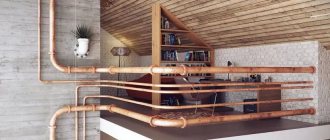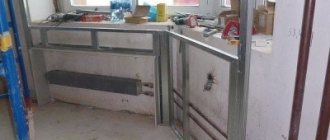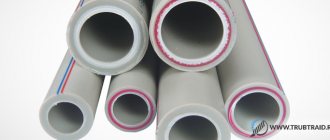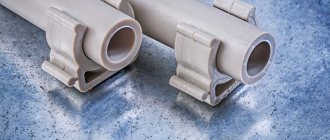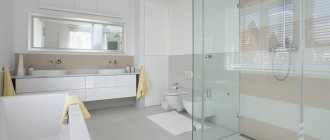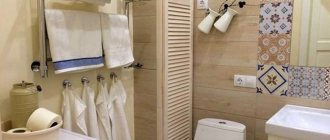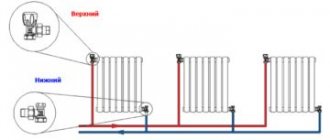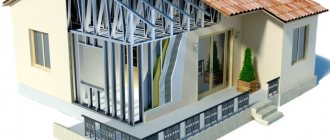To create a holistic interior, owners need to take care of all the details of the design of different rooms of the home. They should pay special attention to closing unattractive communications. We looked at the most convenient and practical options that will tell you how to decorate a pipe or hood. The work can use improvised materials or special building panels and sheets. Depending on the location of communication junctions, different types of decor can be used. It is also important to remember the requirements of government agencies, which may limit the number and type of solutions for different nodes. Having carefully considered all possible types of decoration, the owners will be able to choose an acceptable way to decorate communications without disturbing the overall design style of residential and non-residential premises in the house.
Preparing for work
Before carrying out work with the creation of false walls and boxes, you should take care of the communications themselves. Damaged elements or old connecting parts should be replaced with new ones. This way, it will be possible to prevent problems with their condition in the future. Small ventilation hatches must be installed above the heating elements. This will eliminate the possibility of moisture accumulation and poor-quality heating of the premises. Waterproofing should be done around or under water pipes. For this, thin roll materials or denser tile analogues cut to the size of boxes can be used. Their use will prevent the accumulation of moisture and the destruction of the finish and the appearance of mold. As for old metal communications, they should first be cleaned with sandpaper and covered with a new layer of paint (resistant to high temperatures and moisture).
Place inside walls or floors
Pipes can be hidden inside walls or floors. It is very convenient and aesthetically pleasing. To lay the main line, a groove is made, the pipes are wrapped in heat-insulating material and laid in a recess in the wall, then it is sealed or covered with plasterboard.
All connections and valves should under no circumstances be walled up in the wall - in the event of a breakthrough, it will have to be broken down. Old pipes cannot be insulated in this way.
Decor features
Before you play with communications, you should take into account some of the features and requirements for them. For example, a gas pipe in a kitchen may not close completely. The best solution for it would be to decorate or paint it. In residential premises it is allowed to install false walls and boxes. If necessary, they can be supplemented with a mesh or grille for ventilation. Any materials can be used for finishing and assembly: they will not be subject to special influences. But in the bathroom it is necessary to use only those materials that can withstand high humidity. These include lining, moisture-resistant plasterboard sheets. To close vertical communications, you can use different solutions: cladding and decoration will not lead to a reduction in space. But horizontal communications should be closed only after careful consideration of available solutions. After all, even a small covering can lead to a limitation of free space.
Which decorative screen is better?
At the moment, decorative boxes for pipes of heating systems are made from the following materials:
- plastic;
- metal;
- MDF;
- wood.
Plastic is one of the worst materials for making boxes designed to hide hot pipes. The fact is that in order to reduce prices, manufacturers use inexpensive types of plastic for these products. Such material quickly warps from heating, loses its appearance, or even turns yellow and becomes brittle. Of all types of screens, a plastic pipe box is the cheapest, but it does not last long and is well suited as a temporary solution to the problem. The plastic box made to look like a plinth deserves attention, but this is a different price category.
Metal, on the contrary, is the best solution for decorative fencing of heating risers and mains. Products with frequent perforations or lattice designs are especially good. Metal is an excellent conductor of heat and will successfully transfer it into the room, and through the holes the casing will allow enough air inside for heating. So from the technical side, metal has no equal.
From the point of view of operation, steel products are also at their best. They are coated with a durable polyester powder coating that can withstand high temperatures and various mechanical stress. Again, metal boxes can always be repainted if necessary, so they will last a long time. Well, the last argument in favor of steel screens: they are easy to clean in any way, even wipe with a rag, or remove and wash in the bathroom under running water.
Painting
Stylizing them using paint will help you create a catchy and unusual design for communications in any room of your home. Solutions in this direction can be divided into the following types:
- creating an accent. Excellent for heating systems in bedrooms and living rooms. For example, against the background of blue, turquoise, and purple walls, yellow and orange batteries and wiring will look striking.
- neutral design. For this method, the paint should be selected to match the finish used. The optimal solution for communications located in front of plain wallpaper, paint, and tiles.
- interior styling. To ensure that toilet wiring or wiring in a bedroom with colorful tiles or wallpaper stands out minimally, it is recommended to complement the plain painting with thematic patterns, ornaments or designs.
Using paint, you can stylize the vertical layout as wood in the hallway or children's room or living room. To do this, a crown is depicted on the wall, and the tubes themselves act as a trunk.
How to decorate a heating riser: a selection of ideas for the practical and creative
To disguise your heating system yourself, you don’t have to be a design guru. It is enough to have minimal painting skills and at least a little creative thinking.
Pipes will not be conspicuous if you hide them behind your desk
See alsoHow to decorate a room with your own hands using improvised materials
Experiment with colors
By choosing the right color, you will not only organically “fit” the riser into your room, but also inhale fresh notes.
Pipes can be used as decorative elements, specially highlighting them with contrasting paint
See alsoHow to decorate a wall in a room with your own hands: the best decor ideas
Decoupage
A simple way to decorate communications in a living room or dining room is to carry out decoupage. For it you can use decorative paper, newspaper and even napkins with small pictures. Doing the work yourself is quite easy and quick. To perform it correctly, you can use the following scheme:
- Clean the surface of communications with fine sandpaper. Remove dust using a stiff brush.
- Cover the communications with construction adhesive that is resistant to temperature changes and high humidity. It is recommended to do the work in stages: conditionally dividing communications into several parts.
- Place sheets of newspaper and napkins pre-cut to the diameter of the communications on top of the glue.
- Carefully process the attached materials using a flat, stiff brush, removing air bubbles and leveling the surface of the pattern.
- After the adhesive composition has completely dried, coat the paper materials with acrylic varnish with an increased degree of resistance.
Application of the railing system
If anyone doesn’t know, a railing system is a railing pipe and various accessories, devices and devices suspended on it. It is possible to use a gas pipe in this capacity, taking certain precautions.
Firstly, it is not recommended to overload it or upgrade it.
Secondly, such use is possible if the pipe is in the required location and placed horizontally. If the pipe is located above the kitchen work area, you can paint it with the required paint and hang hooks with utensils.
Another option for using a railing system is to position the rails so that they hide the gas pipe as much as possible. The latter will only need to be painted with the required paint, which will make it as invisible as possible.
We use bamboo
The use of bamboo will help to decorate communications in the kitchenette, sanitary facilities and living room in a non-standard way. Hollow trunks with different diameters are sold in construction and gardening stores. It is recommended to select them by first measuring the diameter of the communications being designed. In this case, the internal diameter of the cavity of the selected bamboo should be at least 0.5 cm larger. Otherwise, there may be problems with their installation. It is quite easy to close communications with such columns. It is necessary to make 1-2 vertical cuts on the bamboo. And then just put it on top of the pipe communications. If necessary, one of the edges can be glued with glue for reliable fixation.
When choosing an interior element such as bamboo, it is worth considering the possibility of its integration into the overall appearance of the room. This solution will look appropriate against the background of light brown linoleum or wooden flooring or wooden walls. Fits well into oriental, Japanese style.
Decoration methods
If the pipes in your house or apartment are already old, it is better not to hide them. Firstly, during the installation of various sheathing, the pipeline can be easily damaged, since old materials usually become somewhat brittle. Secondly, such pipes are more susceptible to leaks, so it is advisable to keep them in sight in order to detect the problem in a timely manner.
But this does not mean that nothing can be done with them. With a little imagination, you can easily turn these elements into a wonderful interior detail. There are several simple ways to do this:
- painting. The most obvious method is to give the pipe the desired beautiful color. At the same time, you can choose a shade that will blend with the surrounding environment, due to which the pipeline will not be noticeable. But you can also make a knight's move and play on contrasts - try turning the pipe into a bright spot that interestingly matches the color of the walls. It is likely that this will become some kind of “feature” of your room. Often such a simple option gives a very advantageous effect. The main thing is to choose the right not only color, but also the quality of the paint. It must be heat-resistant, not harmful to the environment and resistant to mechanical stress. Acrylic or alkyd-based enamel is perfect for this;
- finishing. It all depends only on your imagination. You can wrap the battery with beautiful ropes, threads, and rope. A jute cord will also work, but it is quite possible that the design will be appreciated by cats and will not last long. You can decorate it using fabric or a light garland. Artificial plants will also work, but make sure they are made from heat-resistant, non-melting materials. You can also arrange a bamboo finish, or even make a kind of “reminder” out of the pipe, attaching multi-colored stickers with notes to it - then it will have another practical meaning. And if you have experience making furniture, you can connect circular shelves. Naturally, they will not be mounted on a pipe, but on a vertical support, but the camouflage will be excellent, and again, they will be useful. In general, there are a lot of options. It is quite possible that you will come up with some of your own - then share your ideas with your friends on social networks, showing them this article at the same time.
As you can see, heating pipes are not such a terrible element at all. They can be hidden quite easily, or even turned for good, turning them into a bright and interesting detail of the element. Just do not forget in the process that the main function of the pipe is still heat transfer, so do not get carried away with completely closing the element from all sides. It is advisable to leave some gaps for heat to escape: perforations, grilles, etc. In general, a little imagination and work - and anyone will envy your design. Good luck! https://www.youtube.com/watch?v=Wq2dQZ7kZNU
We recommend reading:
What to do if there is an unpleasant smell from the ventilation in the toilet: solving the problem on your own
Arrangement of ventilation in the toilet of a private house: just about the important
What to do if the boiler is leaking from below or from above: the correct methods for identifying and troubleshooting problems
Draping with fabric
It is considered quite elegant to play up PVC and old metal vertical communications with fabric. This is an advantageous solution for living spaces or areas where cooking is carried out. Typically, translucent tulle is used to cover communications. The same canvases should be used to cover windows. You can completely copy the curtains on the windows and use both light and thick fabrics for draping the wiring. In order for the chosen method to look harmonious in the room, you should extend the cornice to the corner where the vertical communications are located and mount it next to them (on the adjacent wall). Thus, the floor-length canvases will cover not 1, but 2 walls at once. Thick canvases can be hung on one side of the window opening and near communications. Or you can use them near the pipe and on both sides of the window. The rest of the space is covered with translucent canvases.
How to hide pipes?
If the industrial style in the interior is not your choice, then exposed pipes in the house can become an annoying misunderstanding and an object of irritation. We list several solutions for masking them:
Important: before starting work, make sure the integrity of the pipe and, if necessary, repair or update it!
Pipes behind the curtains
Drywall boxes
The most popular and practical way. It is more convenient to make the box at the initial stage of repair, but it can be done later. If you don’t have the desire, skills or time, it’s easier to invite specialists.
Important: when closing heating pipes in boxes, be prepared for the heating of the room to decrease slightly.
Pipe box
Do not ignore creating a detailed design of the box - it will allow for more accurate installation. The design should not “eat up” a lot of space. To fit the box into the overall design, decorate it to match the wall decoration.
Idea: The facade of the box can be decorated with a patterned or lattice panel for ventilation and aesthetics.
Box for pilaster
Instead of plasterboard, chipboard, MDF, lining, polycarbonate, plastic panels, cardboard sleeve, etc. are used to cover the frame. When choosing materials, carefully read their pros and cons. Eg,
Chipboard contains harmful formaldehydes, MDF is heavy and expensive, and lining, without protection, is susceptible to rotting and rapid fire.
Construction of a false wall
It is convenient to zone rooms and hide household appliances and pipes behind it.
It consists of two plasterboard panels connected by a frame. An air gap remains inside.
Important: you cannot decorate the radiator and heating pipes with a solid “blind” panel - this will lead to heat loss and the development of fungus.
Pipe behind false wall
A false wall takes away at least 10-20 cm from the room. So why not increase its functionality? When covering the vertical heating pipe along the wall in the living room, consider illuminated niches and shelves for small items. A false wall in a bathroom with a door and shelves makes a practical cabinet for household chemicals.
A partition made of a false wall with elements of stained glass or glass covering the heating pipes will add special charm and elegance to the decor. If the structure is also illuminated, you will get an original night light, creating an atmosphere of comfort and romance.
Stained glass in the wall
Skirting
Wires have been hidden in baseboards for a long time. But it turns out that you can do the same with pipes running along the floor. True, they will require a baseboard that is more massive than usual, which will steal a little more usable space. But such a solution will give the interior a finished look without complex and costly construction activities.
Tip: the shade of the baseboard is matched to the color of the floor, doors or wall.
Pipes under the baseboard
The hollow profile of the plinth is easily fixed in the grooves of the mounting part and removed, which is convenient for pipe inspection. The optimal material for plinths is PVC, acrylic. It adequately withstands temperature changes in pipes, is moisture resistant, environmentally friendly, and resistant to mechanical damage (for example, when washing floors).
Tip: for better visual control of pipes and uniform heating of the room, use perforated screens made of aluminum and stainless steel.
Furniture
When ordering a kitchen set, provide a special false cabinet in which you can hide the pipe. Or upgrade your existing kitchen modules. For ventilation, make several holes in them in inconspicuous places or attach grilles.
False cabinet in the kitchen
Under the horizontal pipes at the top of the wall, you can hang a wide shelf and place kitchen utensils on it. This way the pipe will be almost invisible. In the case of a gas pipeline, the installation of the shelf is carried out extremely carefully.
Tip: To make the pipe less noticeable, paint it the same color as the wall or install a cabinet system underneath it.
In the bathroom, the pipes leading to the washbasin can be easily hidden by a cabinet or pedestal under the sink. An alternative option is to use curtains, baskets and boxes.
Vanity cabinet
Plastic panels
They tolerate moisture well and are easy to maintain, install and dismantle. They are often used in wet areas. A plastic screen can easily hide pipes of different sizes, shapes and directions. The process of its installation is reminiscent of installing a plastic ceiling with a mandatory base frame.
Tip: for a neater screen appearance without traces of fasteners, use decorative corners.
Plastic panels
A common budget option is to install a purchased or homemade plastic screen under the bathtub. Behind it you can hide communications related to both the bathtub and the sink. The free space behind the screen will provide additional storage space for household chemicals.
Bamboo trunk
It’s easy to let a piece of the tropical forest into your home, highlight the Japanese style, and at the same time decorate the chimney in an original way! Bamboo can help you. Having selected it to the required length, cleared of partitions, you need to cut it lengthwise and wrap it around the pipe. Then the cut areas are glued vertically or secured with rope to match the decor.
Tip: bamboo looks original when decorated with artificial or live plants, figurines of birds and animals.
Bamboo for pipe decoration
Roller blinds
It is practical and convenient to camouflage pipes in apartments using plumbing shutters. With them you get quick and complete access to the pipe along almost its entire length. Thanks to a wide range of designs and colors, roller blinds can be chosen to suit any interior style.
Roller blinds in the bathroom
Curtains and cornice
They will perfectly cover pipes located vertically along window slopes. There is no need to install anything special, because curtains and cornices are already needed. Curtains made of dense, non-transparent materials will cope more effectively with the task.
Advice: it is better to choose a cornice longer than the horizontal pipe, and with a projection slightly larger than its girth.
Cornice and curtains
In a bathroom or kitchen in Provence or country styles, pipes under the sink can be hidden with homemade draped curtains. Short curtains are also suitable for horizontal pipes under cabinets, shelves in a nursery, kitchen or laundry room.
Curtains under the sink
With ropes
The original decor of vertical and horizontal communications can be done with ropes. It is not recommended to use the cheapest jute ropes (with an uneven surface) for work, since they quickly become covered with dust and it is difficult to remove. But neat, smooth analogues made of jute (regular or dyed) are suitable for use in living rooms and toilets. Vertical layout using this material can be stylized as wood or palm tree. For such decoration, it is recommended to fix artificial greenery, branches with plastic lemons or oranges in the upper part of the braided communications.
In a small Khrushchev-era building, using thin ropes, you can create original marine decorations. White cotton ropes are suitable for the job. In this case, the horizontal wiring can not only be braided, but also decorated with flowing ropes. Additionally, small shells can be glued to the braid.
Open methods
There is also open decoration of heating pipes.
When using it, the pipes are simply painted to match the walls, then they become less noticeable. When choosing such a disguise, it is important to apply the paint to a cold contour. This means that pipes can only be painted in the warm season.
Paint applied to a hot circuit will dry quickly and then crack. Correcting such a defect will be very problematic.
If you look through the works of experienced designers, you can see other methods of so-called open masking of pipes. Look at the photo. The craftsman wrapped tow around it and stuck artificial green branches into it. He came up with an original tree that fit very well into the interior.
Another designer simply glued bird figures cut out of black paper to a white pipe. The result is a pole on which the world sits a flock of birds.
In fact, this decor of a heating pipe in a room always looks very impressive. It is memorable, creates a mood that creates a warm atmosphere. Here you can let your imagination float freely and try to implement something new.
At the same time, the main thing to remember is that in winter there will be coolant flowing inside, which can melt or damage the materials used. Therefore, when making jewelry, you need to use something that can easily withstand such influence.
It is impossible not to mention the special rings that are installed on pipes without a screen. They do not hide the riser or pipeline, but only add aesthetics to the place where it meets the wall, floor or ceiling. Rings are made of plastic or wood. They look good. Therefore, they are often used for finishing interior decoration.
Stained glass windows and furniture cornices
The use of non-standard solutions for styling an apartment and hiding gas, water, and heating communications makes it easy to transform living spaces and dining rooms. For vertical layouts it is recommended to use stained glass. They can be used to decorate living rooms, adult and children's bedrooms. Stained glass will not only cover communications, but will also become a stylish decoration. If you place a backlight behind multi-colored glasses framed by a wooden or similar body, the finished object will become an auxiliary lamp. In the case where communications are located at the top (ceiling placement), a beneficial solution would be to cover them with furniture cornices. They are installed along the side of cabinets, sets on top and fixed under the ceiling. At the same time, access to communications remains simple, and the space around them remains free.
Curly cornices will fit classic sets, but are unlikely to complement models with bright facades or chrome rails.
Finish price
Drywall is also an available material for decoration. The cost of sheets of this material starts at 200 rubles. But they alone will not be enough to decorate heating pipes. You will also need profiles, the average price tag for which starts from 50 rubles. You will also need skirting boards, the cost of which starts from 20 rubles.
In order for the plasterboard structure, behind which the pipes are hidden, to look aesthetically pleasing, putty is necessary. Prices for such compositions start from 100 rubles. If you decide to build a false wall, then in this case you will have to spend much more on material. You can't get by with drywall. You will also need to purchase wall panels, prices for which start at 150 rubles. for 1 sq. m. You will also need screens for radiators, which cost 300 rubles in stores.
You can also decorate heating pipes in an apartment by using jute rope. This material is quite inexpensive. The maximum price for it is 120 rubles. for 1 linear meter. You can also use hemp rope, prices for which vary from 10 to 880 rubles. The most expensive method is stained glass. If you choose this option for decorating pipes in your apartment, you will have to pay several thousand rubles for this pleasure.
Drywall box
It is quite easy to close the exhaust ventilation duct and plumbing connections using drywall. From it you can assemble a structure of any shape and size, allowing you to change the layout of the room. In this case, all communications will be closed from prying eyes. This approach can also be used to hide chimneys. Work on assembling the structure is carried out as follows:
- Marking the sides of the structure relative to the closed communications. Requires taking into account the thickness of the plasterboard sheets used for work.
- Screwing guides and supporting profiles.
- Screwing plasterboard sheets (pre-trimmed) to the profile frame. For work in sanitary facilities, it is recommended to take moisture-resistant sheets, for residential premises - ordinary ones.
- Grouting and protecting seams, installing additional elements (corners, plumbing hatches)
- Finishing the structure with tiles, painting, wallpapering.
Common mistakes
Among a number of mistakes that novice masters often make are:
- the absence of special doors in the box or false wall in the places where detachable fittings and shut-off valves are installed, allowing quick access to them in the event of an accident;
- lack of thermal insulation when pipe wiring is hidden in the walls or floor;
- move heating pipes in apartments without agreement with the relevant organizations;
- installation of blind frame boxes without ventilation holes or grilles necessary to ensure natural air circulation.
Laminate box, MDF
The assembly of structures from wood boards and similar materials is suitable for communications located above the baseboards leading to the basement. Their base should be assembled from slats. The use of timber and boards will allow you to quickly create a durable frame, complemented by a liftable MDF door or a fixed top. Using slats, you can assemble a completely removable structure. The top can be covered with laminate. The sizes and materials of different types of boxes are determined individually. The use of slats and laminate will result in significant costs. Wood boards and plywood will cost less, but their appearance will be simpler. Therefore, this type of box is recommended to be made for rooms where strict styling is not needed. The use of expensive laminate is mainly for rooms with a distinct stylistic direction (for example, modern, Provence, Scandinavian).
Unusual ideas for corridor design
Each of the above styles has its own characteristics and, of course, it’s up to you to decide what your corridor will look like. But there are still a few working tips left from modern interior designers, which would not hurt to take into account for a successful and harmonious arrangement of space:
Firstly, do not be afraid to use decorative stone in decorating a room. They can be used to decorate the front door or corners. The main advantage of using this material is that it goes well with other types of finishes.
You can do whatever you want with stone, taking into account, of course, the style in which the rest of the room is decorated. Depending on the stylistic direction in which your room is designed, you can play with stone, choose certain colors and materials.
Secondly, use photo paintings and 3D images in the design of the room
They will help distract attention from uneven walls, increase space and even add coziness. They can be either small or large in size
Keep in mind that 3D images are only suitable for free spaces.
Thirdly, try to expand the space with mirrors. One of the interesting trends in corridor decor is decorating the walls with floor-length mirrors. On the one hand, this is an original and unusual way to arrange a room, but on the other hand, it is very risky, because not every person will feel comfortable in such a room.
False wall
In a situation where the pipework is large and creating a small box will not solve the problem, you should make a full-fledged false wall. It is assembled from profiles and plasterboard sheets. It is recommended to supplement the created ledge with a plumbing hatch. This will allow owners to easily access communications and repair or replace them. In plumbing rooms, the false wall may be non-standard. To do this, boxes are assembled on the left and right, and plumbing roller shutters are hung on top of them. This solution will allow you to instantly gain access to the wiring, eliminate the leak and carry out a complete replacement of communications without delay. The false wall itself can be covered with wallpaper or painted or tiled. Moisture-resistant plasterboard sheets should be used as a base.
Non-standard approaches
In the kitchen, the heating radiator can be hidden in a small bedside table. It looks good in this room next to the window, and the advantage in this situation is the additional space in the kitchen for storing kitchen utensils. This is how aesthetics are combined with practicality.
You can look at this question with a creative slant. And then you don’t need to hide the heating pipes, but you need to embellish them a little.
For example, you can interestingly change a child’s room if you decorate the radiator and pipes to look like a tree trunk. And the golden-colored radiator in the hall will remind you of carefully folded gold bars.
How to hide heating pipes in a private house or apartment is up to everyone to decide for themselves. By using these recommendations, using your imagination and creativity, you will make this problem easily solvable. Let your home be cozy and comfortable.
